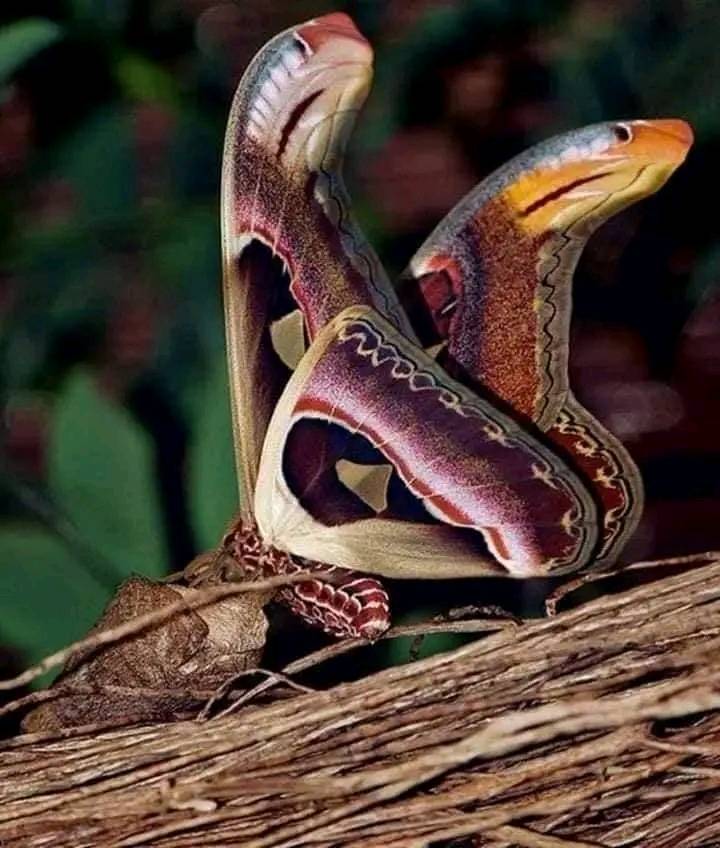Habitat
Attacus atlas is primarily found in tropical and subtropical rainforests (Peigler, 1983). These forests do not have four seasons, but rather a dry and a wet season. They are characterized by closed canopies, broad-leafed
evergreen trees, and temperatures approaching but not exceeding 25°C. The moths spend the majority of their lives on a single tree: laid on the leaves as eggs, eating the leaves as larvae, pupating off the branches, and resting in wait for a male mate as an adult female (CAB International, 2020a).
No formal studies have been conducted to investigate the range of elevation, though A. atlas is widely considered to occupy habitats of elevations from sea level to 1500 to 2000 m. ("Attacus atlas (atlas moth)", 2020; Peigler, 1983)
- Habitat Regions
- tropical
- terrestrial
- Terrestrial Biomes
- forest
- rainforest
Physical Description
The female atlas moths are larger than the males. The body length of Attacus atlas was determined under lab reared conditions to be 39 to 40 mm in females and 30 to 36 mm in males and the wingspan ranged from 240 to 250 mm in females and from 210 to 230 mm in males (Bhawane et al, 2011). The forewing in males is 73 to 125 mm long with a mean of 102 mm, and the hindwing is about 48 to 72 mm long with a mean of 69 mm (Peigler 1983). In females the forewing is 93 to 131 mm long (mean of 119 mm) and the hindwing is 76 to 101 mm long (Peigler 1983). The wingspan is among the top five largest moths in the world. The shape of the wings is rounded, with the forewing having a protrusion from the anterior distal edge. The base of the wing is colored deep orange, soft brown, or deep reddish brown and is patterned with white, black, brown, and pink coloration, with a large white triangular hyaline spot in the center of each wing (Hampson, 1892; Peigler 1983). The protrusions and edges of the wings resemble the head and body of a snake (Hampson, 1892; Peigler 1983). The undersides of the wings are pattered the same as dorsal sides but may be paler in color.
The mouthparts of the adult are non-functioning, with some parts disfigured or completely absent (Britannica 2013). They have two large compound eyes. They have two yellowish brown bipectinate antennae, meaning the antennae are comb-like on both sides (Hampson 1892). The antennae measure 23 to 39 mm long and 10 to 13 mm wide in males and 17 to 21 mm long and 3 mm wide in females (Bhawane et al, 2011). The body is reddish to orangish brown and can vary in shade (Hampson, 1892).
Attacus atlas is distinguishable from other similar moth species in the genus g. Attacus by the presence of a patch of yellow or orange above and below the red dash in conjunction with a prominent white component of the postmedian and antemedian lines (Peigler, 1983). The red dash is longer and thicker in A. atlas than in Attacus mcmulleni, which bear similar resemblance (Peigler, 1983).
The eggs are yellowish white to pale yellow and are oval and flattened consistent with all moths in the family Saturniidae (Bhawane et al, 2011). They are covered in a gummy substance used for attachment to each other and the leaves (Sathe and Kavane, 2014) The size ranges from 2.7 to 3 mm in length and 2.1 to 2.7 mm in width (Bhawane et al, 2011).
The larvae are pale green with orange or brownish speckles and a bright orange ring on the anal somite (Bhawane et al, 2011; Hampson, 1892; Peigler, 1983). There is a white waxy substance on the dorsal side of the larval body which begins developing in the 2nd instar (Bhawane et al., 2011). The first two instars have darker heads and body coloration between the scoli. The body length varies from 8 to 10 mm in the first instar to 88 to 92 mm of the fifth and sixth instars (Bhawane et al., 2011). The 1st, 2nd and 3rd somites have dorsal protrusions (Bhawane et al, 2011; Hampson, 1892). The 4th through 11th somites have dorsal and subdorsal blueish green scoli (branched, thickened spines protruding from the body) and black lateral scoli below the spiracles (Bhawane et al, 2011).
There are a few key differences in the larvae of A. atlas and the related species Attacus lorquinii and Attacus caesar. The dorsal, subdorsal, meso- and metathoracic scoli of A. atlas are flattened and greenish while that of A. lorquinii are rounded yellow knobs about 2mm long and that of A. caesar are flattened and yellowish (Peigler, 1983). The patch on the anal prolegs of mature A. atlas larvae is a light greenish blue surrounded by a bright orange ring (Peigler, 1983). In A. lorquinii the patch is solid brownish orange and in A. caesar it is solid brownish orange with a bright yellow edge (Peigler, 1983).
In the pupal stage, the pupa, comparable to the chrysalis of a butterfly, is surrounded by a cocoon, a papery outer covering of the pupa. It serves as camouflage as A. atlas pupates in the trees (Peigler, 1983). The cocoon coloring of A. atlas varies depending on the host plant from a blackish brown to a brownish yellow to whitish, though most commonly cocoons are light brown (Bhawane et al., 2011; Peigler, 1983). The cocoons may be spun with highly variable size shape, color and texture (Peigler, 1983). The pupa itself is dark brownish orange, smooth and shiny and is 35 to 55 mm long (Bhawane et al, 2011).
Basal metabolic rate is not known. (Bhawane, et al., 2011; Britannica, 2013; Hampson, 1892; Peigler, 1983; Sathe and Kavane, 2014)
- Other Phys
- bilateral symmetry
- Sexual Dimorphism
- female larger


